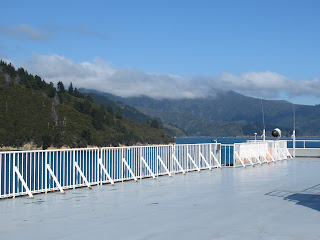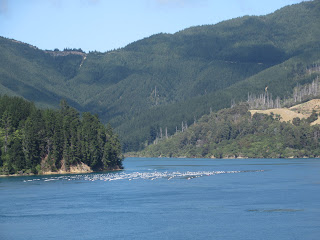After driving down a good chuck of the North Island the day before to reach New Zealand's capital city of Wellington, we arrived early this morning to get to the city's Interislander ferry terminal to take the 3.5 hour ferry to Picton on the South Island where we'd planned to spend the majority of our visit to New Zealand.
The distance from Wellington on the North Island to Picton on the South Island is 92 kms and Cook Strait is 22 kms wide at its narrowest point. The origin and meaning of the Maori or native name for the strait are unfortunately obscure. The English name first appeared in Captain Cook's chart of 1770. The strait can be flat, calm and peaceful but it is frequently subject to strong winds and an average of 22 gales per year.
The local rip tides are also notorious for both their strength and unpredictability, especially one area called the Karori Rip. I read about one intrepid kayaker who, attempting to paddle the strait, spent 18 hours battling tidal rips before making landfall - and that was where he'd started! It was only when I read one of the information panels aboard the ferry that when we would disembark in Picton, we'd really be no further north or south than when we started. I didn't understand that as surely the 92 km distance between the two islands meant we'd have traveled that many kilometers south, no?
There were vineyards as far as the eye could see as we drove toward the east coast of the South Island. Apparently, there are over 60 vineyards just in this small area of New Zealand for the dedicated oenophile to explore.
Minutes later, barren windswept hills led to New Zealand's only salt works at Lake Grassmere where, after salt water is pumped into its 1800 hectares, evaporation takes place to create nearly 40,000 tons of salt annually. We didn't stop but the giant mountain of salt was very evident as we drove on by.
After driving for a few hours from Picton, we finally reached the east coast of the South Island and the Pacific Ocean. It was strange seeing the Pacific on NZ's east coast as we in North America always think of it as being on the west coast!
Next post: Exploring Christchurch, a city that had already known so much tragedy before the horrific events of March 15th.
Posted on March 21st, 2019, from Taranna in the state of Tasmania, Australia.
The crossing was delightfully smooth for the first 90 minutes or so as the ferry was so mammoth we hardly felt it moved at all. The journey was made all the more pleasant as an older NZ couple sat beside us as they were also going to Christchurch, our final destination for the night. They, however, were only spending one night on the island and would be traveling by train to see his brother. The wife explained the trip was on her husband's bucket list after he'd had ten heart attacks. He had more lives than a cat, she joked!
NB: This post is about our visit to New Zealand's South Island before the mass shooting that took place nine days later in Christchurch.
She talked about the challenges facing their nation with the changing face of the country after the waves of immigrants and the 'demands' as she put it that she felt some of them put on their new homeland. She seemed quite upset that the newer residents (or possibly citizens?) wanted to change the national anthem and other long-held cultural standards to reflect the newcomers' non-Christian beliefs rather than assimilating into the new country that they had chosen to come to. I am sure the impact of immigrants was felt more strongly because the country only had a population of 4.5 million people.
The cruise took us through the majestic Marlborough Sounds, a haven of sheltered inlets, coves and crystal-clear waters. I could certainly understand why the ferry trip across the Cook Strait which connects the two islands was considered one of the world's most scenic.
Cruising later into the Queen Charlotte Sound was a breathtaking introduction to the South Island’s beauty.
After getting blown away on the top deck, Diane decided to return below deck but I preferred to feel the wind through my hair and get some marvelous unobstructed views.
Our new companions on board the ferry told us there were so many fewer people living on the South Island compared to the North Island that we shouldn't be surprised if people wave at us when we drive by!
Sadly, we passed an area where forest after forest of kauri trees had died off from a disease. Unlike the nascent furniture industry that has made attractive blue-tinged items the last few years in Colorado in response to the pine beetles that have killed off millions of trees in the US West, we were told that to date the kauri trees weren't being recycled and no money was being made from the felled trees.
Keep your eye on that little white dot on the top of the rock!
Someone had lovingly taken the time to craft a wee home on the cliff to amuse cruise ship passengers and boaters passing by!
Diane and I were lucky that the sea was calm for almost the entire journey and that neither of us had ever experienced seasickness. There was one stretch, though, I was glad Diane had brought some Dramamine along because I thought I might need some. The ferry 'only' carried 900 passengers out of a maximum of 1,375 and just 600 vehicles that day. We were both so glad we'd chosen to take the ferry between the two islands and not flown as we'd have hated to miss that exciting journey. Regular travelers on the ferry reported often seeing whales but we didn't see any that day.
The ferry staff had the disembarkation process down pat once we arrived in Picton so we were on our way heading south in no time through the Marlborough Wine Area. There were vineyards as far as the eye could see.
If we saw this sign once, we must have seen it a hundred times or more as we drove through the South Island. I swear each time we saw it, we both smiled at what was such an unusual sign for us!
The ferry staff had the disembarkation process down pat once we arrived in Picton so we were on our way heading south in no time through the Marlborough wine area. The hills looked so bone dry, almost as if a fire could wreak mammoth devastation in no time.
Neither of us had ever seen vines covered with netting before; we thought it was possibly due to pests but didn't know and there was never an opportunity to ask anyone unfortunately as it was a very common sight.
A sign said this was the Puka Puka Quarry but neither of us had a clue as to what was being excavated.
After driving for a few hours from Picton, we finally reached the east coast of the South Island and the Pacific Ocean. It was strange seeing the Pacific on NZ's east coast as we in North America always think of it as being on the west coast!
As you can see from the photos I took, the views of the turquoise-studded waters were stunning. We were lucky with the route we'd chosen as the sea was always on our side of the road as we drove south, as drivers always are on the left in New Zealand. We saw plenty of signs reminding drivers to keep left because so many international drivers have caused serious accidents driving on the alternate side of the road. I am sure views like this would also cause many drivers to lose their focus. There were also a huge number of safety messages like the one sponsored from the music group, Legend, that said "Mates don't let friends drive drunk."
We knew our companions from the ferry would soon be
enjoying these same spectacular views on the train tracks that hugged the
shoreline as they also headed toward Christchurch. In the distance, we caught
out first glimpse of snow-capped peaks here in New Zealand.
We stopped at the highly recommended Store Cafe in Kekerengu to get a sweet for each of us and coffee for Diane to keep her going for the rest of the day's drive.What a great place to relax for a bit as you can see from the big smile on my face!
It was just a short walk from the cafe to the beach where there were piles and piles of driftwood which would have been the envy of any woodcarver.
It was hard to imagine a more beautiful scene than the blue
sky, turquoise waters, green shrubbery, and the hundreds of sheep on the
pasture.
Our journey to Christchurch was slowed down by at least an hour because of the constant road repair to the highway once we hit the coast. It was hard to complain about the constant stop and go traffic as the views were out of this world all along the coast. Stopping to see the seals sunning themselves on the rocks at Ohau put a smile on both our faces!
Watching the baby seals cavort in the shallow waters for several minutes was a hoot!
This gives you a sense of how twisty and turny the highway was as it hugged the shoreline and the cliffs. We passed several stands that sold lobster rolls to hungry passers by along what is dubbed the crayfish coast.
The big sphere was the Welcome to Christchurch sign - after getting up so early that morning to catch the ferry in Wellington, the long ferry ride across the Cook Strait and then the five or so hours down much of the island, we were spent by the time we arrived at our hotel.
Next post: Exploring Christchurch, a city that had already known so much tragedy before the horrific events of March 15th.
Posted on March 21st, 2019, from Taranna in the state of Tasmania, Australia.

















































Great to start reading about your trip again. I still can’t believe how bad the internet has been in New Zealand.
ReplyDelete